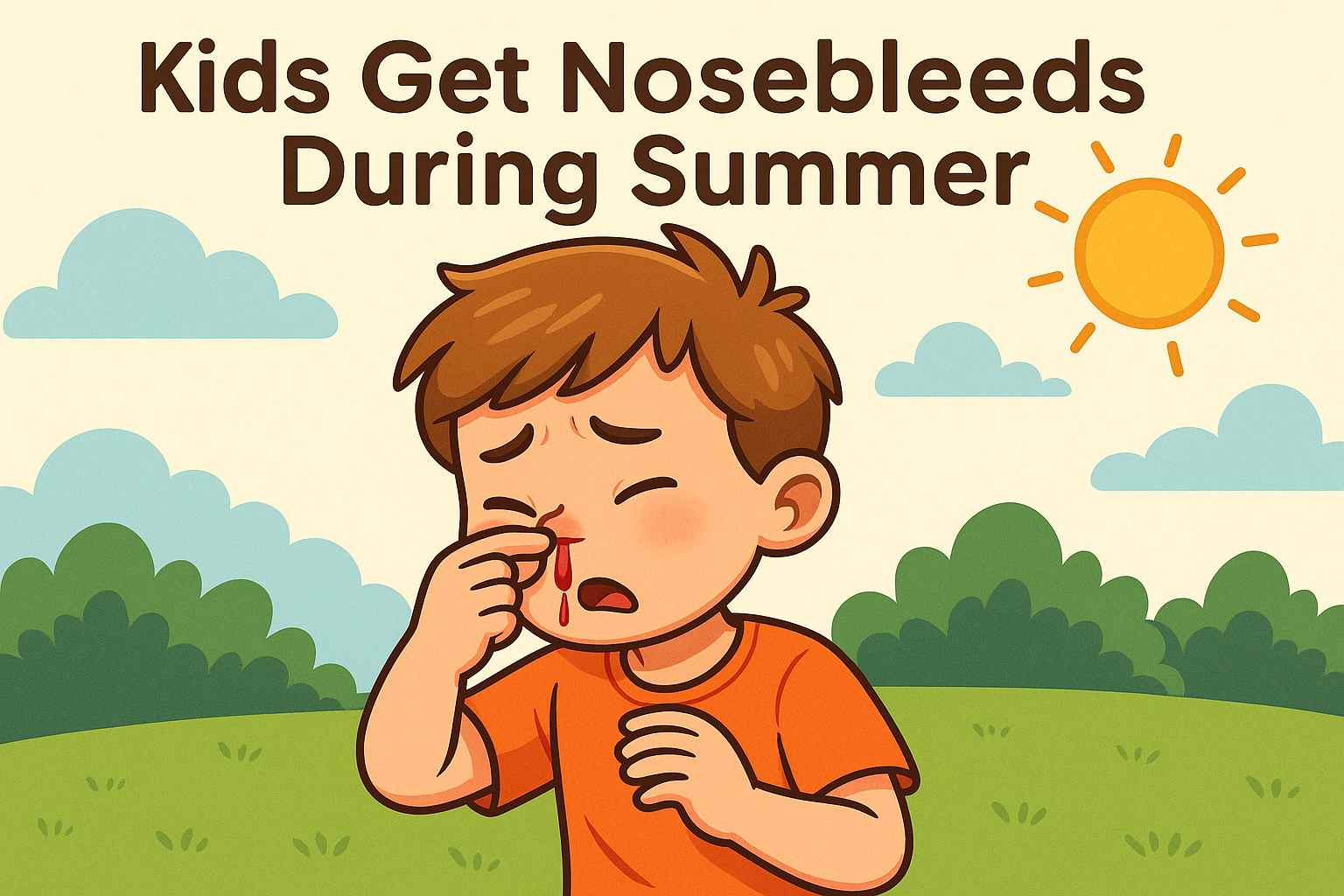
Why Do Kids Get Nosebleeds During Summer?
Nosebleeds, or epistaxis, are a common occurrence in children, especially during the hot summer months. While most nosebleeds are not serious, they can be alarming for both children and parents. Understanding the causes, preventive strategies, and proper treatments for nosebleeds is essential to managing them effectively and avoiding unnecessary panic.
1. Introduction to Nosebleeds
A nosebleed happens when blood vessels inside the nose rupture. The inner lining of the nose is rich in tiny blood vessels that are located close to the surface. These vessels are fragile and can easily break, leading to bleeding. Nosebleeds in children are most often anterior nosebleeds, meaning the bleeding originates from the front part of the nose.
Nosebleeds are particularly more common during summer due to a variety of environmental and physiological factors. Although they can look dramatic, most childhood nosebleeds are harmless and easily treated at home.
2. Types of Nosebleeds in Children
There are two types of nosebleeds, and children generally experience the anterior type:
a. Anterior Nosebleeds
- Originates from the front of the nose
- Most common and easily managed
- Usually caused by nose picking, dry air, or minor trauma
b. Posterior Nosebleeds
- Originates from deeper inside the nose
- Rare in children
- More serious and usually requires medical attention
3. Common Causes of Summer Nosebleeds in Kids
| Cause |
How It Triggers Bleeding |
| Dry air (AC or outdoor) |
Dries nasal lining, leading to cracks |
| Dehydration |
Reduces nasal moisture |
| Allergies |
Causes inflammation and rubbing |
| Heat |
Expands blood vessels |
| Trauma (e.g., nose picking) |
Physically ruptures vessels |
4. Symptoms of a Nosebleed
Besides the obvious sign of blood flowing from one or both nostrils, children may also experience:
- Blood flowing from one or both nostrils
- A feeling of fluid in the throat
- Blood-stained tissues or pillowcases
- Dizziness or mild headache (if blood loss is prolonged)
- Dry, crusty nostrils
If a nosebleed lasts more than 20 minutes, seek medical attention.
5. How to Manage a Nosebleed at Home
Managing a nosebleed properly can reduce anxiety and help the bleeding stop faster .
Step-by-Step Management:
- Stay Calm: Reassure the child to sit still and stay calm.
- Positioning: Sit the child upright and lean slightly forward. Do not tilt the head back; this may cause blood to flow into the throat.
- Pinch the Nose: Pinch the soft part of the nose (just below the bony bridge) and hold for 10-15 minutes without interruption.
- Cold Compress: Apply a cold pack on the back of the neck or nose.
- Avoid Talking or Sneezing: Keep the child still and discourage talking, laughing, or blowing the nose immediately after bleeding stops.
6. When to Seek Medical Help
Although most nosebleeds are harmless, consult a doctor if:
- Nosebleed lasts longer than 20 minutes
- Happens frequently (more than once a week)
- Child feels light-headed or shows signs of anemia
- Bleeding from both nostrils or after a head injury
- There’s blood in the mouth or vomit
7. How to Prevent Nosebleeds in Summer
Preventive strategies can help minimize or completely avoid nosebleeds during summer:
- Keep the Nose Moist: Use saline sprays or ointment to keep nostrils hydrated.
- Use a Humidifier: Prevents dry air in AC rooms from drying out nasal lining.
- Encourage Proper Nose Care: Avoid nose picking, trim nails, teach gentle blowing.
- Hydration: Ensure frequent fluid intake, especially in hot weather.
- Limit Heat Exposure: Keep kids indoors during peak heat hours.
- Manage Allergies: Use antihistamines if necessary, keep windows closed.
8. Nutritional Support for Stronger Blood Vessels
A well-balanced diet strengthens blood vessels and supports nasal health:
- Vitamin C: Citrus fruits, guava, amla
- Vitamin K: Green leafy vegetables
- Iron: Spinach, jaggery, dates
- Zinc: Pumpkin seeds, nuts, legumes
9. Myths vs Facts About Nosebleeds
| Myth |
Fact |
| Tilt the head back |
This can cause choking. Always lean forward. |
| Only trauma causes nosebleeds |
Dryness and heat are more common triggers. |
| Frequent nosebleeds mean a serious illness |
Usually harmless, but persistent ones need a check-up. |
| Nosebleeds can be stopped with cotton |
Cotton may irritate more. Use pressure instead. |
10. Medical Treatments and Interventions
In case of frequent or severe nosebleeds, a doctor may recommend:
- Topical antiseptics or antibiotics
- Silver nitrate cauterization
- Nasal packing
- Treating underlying allergies or infections
- Blood tests if bleeding disorders are suspected
Conclusion
Summer nosebleeds in children are usually caused by dry air, dehydration, allergies, or minor trauma like nose picking. While they are often harmless and can be managed at home, understanding the causes and practicing preventive care is key to minimizing their occurrence. Keeping your child well-hydrated, maintaining nasal moisture, and managing environmental factors can go a long way in preventing summertime nosebleeds.
In case of frequent episodes or prolonged bleeding, always seek professional medical guidance to rule out any underlying issues.
Book your appointment today with our expert and take the first step toward better health.
Reads also
Learn French